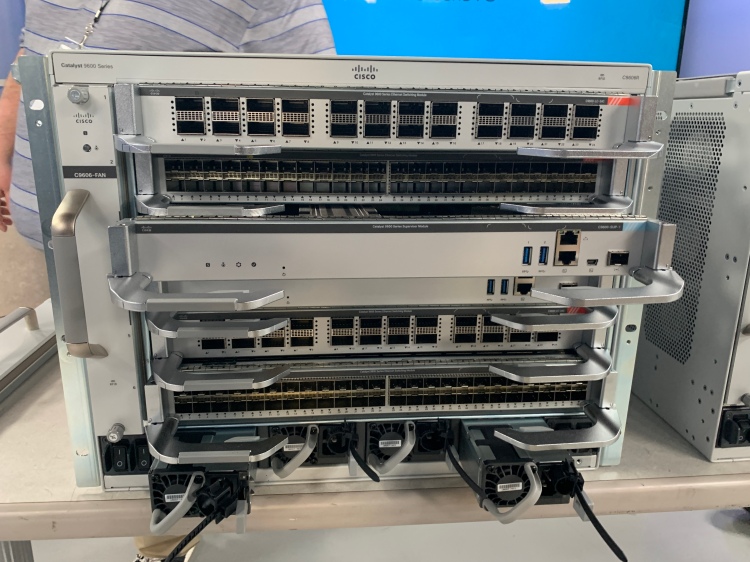Introducing the Catalyst 9600

Photo: A.J. Murray, NoBinkyBlinky
Are you #WiredForWireless – Today Cisco announces new 8211ax/Wifi6 Catalyst AP line up and Campus Core switching Platform, the new Catalyst 9600 for Campus Core.
I’m excited to finally share with you the details of my trip to San Jose a few weeks back! Recall, I got an invite out to Cisco HQ in San Jose, CA to get some pre-release information on today’s forth coming announcements from Cisco.
Speeds at the access layer are increasing! Demand for access layer bandwidth is higher than it’s ever been. The solution – multi-gig (greater than 1 gig) access layer switches and wireless access points. But, to feed these solutions we need more robust core and distribution layer switching. The solution – Catalyst 9600 modular platform.
The Catalyst 9600 enters the market as the last piece of the CAT9K series puzzle. It compliments the rest of the line up, the CAT 9200, 9300, 9400, and 9500 series switches. And this is ultimately an upgrade to the 6500 and 6800 series Catalyst platforms.

The initial release of this new chassis platform is the C9606R, an 8 RU “cube” chassis complete with two slots for redundant supervisors and four high performance I/O slots, with available options – which I’ll get to.
The Chassis
The 9600 series chassis has a lot of the same features we’re already familiar with, found in the current 9K family. This chassis boasts a dual-serviceable fan tray. The tray can be inserted into the chassis from the front or flipped around and accessed from the rear. This provides greater flexibility in even the tightest of switch closets, and options depending on cable paths.

Photo: A.J. Murray, NoBinkyBlinky
The chassis also has built in RFID so you can wirelessly pull inventory information off from it. This is similar to a lot of other technologies implemented in the modern, cloud ready, enterprise campus core. Blue beacons, or little blue lights, that quickly identify the component you’re after – whether it’s a sup card, I/O card, power supply, or fan. Just activate that component’s blue beacon and you can easily identify it, even in a sea of hardware. This chassis also has four modular 200W power supplies.
Additionally, this chassis has retractable hand holds so you can easily lift, move, and install the 9600. Also, large claw like release handles to easily install and remove line cards. No more messing around with tiny screws!

Photo: A.J. Murray, NoBinkyBlinky
Something unique to this new series of switches, compared to previous line ups of Catalyst switches, is that the entire Cat 9K family shares the same hardware and software architectures. The same common building blocks: x86 multi-core processors, Cisco’s UADP 3.0 ASICs, and a single OS platform -IOS-XE. Because of this there’s really only a single IOS-XE that can run across the entire CAT9K series. Previously, you had to identify platform specific releases of IOS based on the hardware.

This 8RU chassis has a total capacity of 25.6 Tbps!! Wait till you see these cards! (I have pictures. Read on!)
The Supervisors

These supervisors are ready for work! They come equipped with dual 4-core Intel Broadwell series CPU’s, 16GB of memory, and optional M.2 storage, available in 240GB, 480GB, or 960GB. Yes, you read that right, M.2 storage on a switch! This platform will have the capability to run virtual workloads, including containerized apps!
The newest version of the UADP 3.0 ASIC’s allows us to bring in different types of encapsulation into the campus core, like MPLS and VxLAN. So, you’ll be able to run these technologies right from the campus core without the need for additional hardware. You can do it all right from this platform.
Chassis platforms are unique, when compared to static switching platforms, in that you’re making an investment in your infrastructure. You buy a chassis for the long haul. As your organization grows and technology changes you can add or upgrade line cards to meet business needs and introduce new technology without having to replace the entire platform or do a forklift upgrade. The same is true for these 9600 series supervisors. In the future new supervisor cards will be released with improved hardware and functionality. Simply installing a new supervisor means you’ll get more bandwidth, new features, and more. These initial supervisors will support 9.6 Tbps of capacity – on just a single supervisor.
As you can see with specs like this all the work is happening at the Supervisor. With these improved architectures Cisco was able to achieve a 5 microsecond stateful switch over in the event of a failure. It’s also worth noting here: there are actually less components at play. Fewer components means there’s less of an opportunity for things to break. Due to this the MBTF – Mean Time Between Failures – is significantly higher (more than doubles current MBTF) than other chassis.
And, of course, as with the rest of the CAT9K family, this platform continues to provide the processing power and bandwidth necessary to support the real time telemetry that goes into Cisco’s Intent Based Networking solution.
Line Cards
Upon initial release there will be two different line card options available, with additional configurations coming in the future.
The first is will be a 24 port 40G/100G QSFP line card. The card can operate all 24 ports at 40G line rate, or 20 ports at 100G line rate. When 100G is enabled the neighbor port is shutdown.
The second will be a 48 SFP port line card capable of doing 25G, 10G, and 1G.

Photo: A.J. Murray, NoBinkyBlinky
Remember, the primary mission of the 9600 is to operate in the core – so we are moving data as quickly and efficiently as possible out to the distribution layer.
My First Impressions
Let me start this by saying – I’m a Network Deployment Engineer for Enterprise Networking and Security, and I absolutely love what I do! So, I am very excited about what Cisco has announced today with this new Switching platform and the new 802.11ax/WiFi6 Catalyst 9100 APs (You can read more about those from fellow Cisco Champion, Kevin Blackburn – TheRoutingTable.com)
With the Cat 9K series now complete, Enterprises of all sizes can now put the power of Intent Based Networking Architecture to work across their entire network, from core on through to access.
I’m very excited to see what the future of the Catalyst 9600 series has to hold as new chassis sizes, line card options, and eventually new supervisors are released. I am also looking forward to helping my customers implement these new platforms into their networks.
I’ll be following this series closely as it continues to develop, and as I am able to learn more and get hands on with them I’ll continue to share my experiences and feedback here.
To learn more about this exciting new platform you can check out this presentation, I attended, from Shawn Wargo, Principal Engineer at Cisco.

4 thoughts